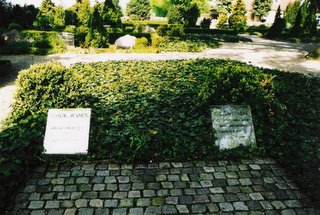
Nature: Orchids, Peregrine Falcon
See my blog today: "A Taste of Denmark" Møns Klint



The Klintekongen, (Cliff King) was awesome. He was a "mountain man" who ruled in his cave under the cliff. The brave young men, who went down to the cave to find him, never came back. And the girls who dared to look into the eyes of his son, the prince, became so enchanted that they danced with him into the cave and stayed there forever.

History in the Middle Ages:
In the Edda is mentioned a locality which supposedly is Møn. According to legend two wights ruled the island. One at Høje Møn (Cliff King) the other was Green or Green Hunter at the western part of the island, where Grønsund ( Green Sound) and the Green Hunter's hill were said to be named after him.
During the Middle Ages Møn was of great economic importance caused by the herring fishing in Øresund and its placing close to the markets in Skåne. Both Stege and Borre were important towns. Stegeborg (castle) was one of the most important fortifications in the country. After Møn had been plundered by the Wends, the island became in Valdemar the Great's rule a starting point for war-expeditions to the Wend. In 1252 the German Henrik of Æmelthorp conquered Møn - and in 1289 the island was attacked by the outlaws (Marsk Stig and his men) and the Norsemen. During Lübeck's war against king Hans the town Borre was destroyed, while Stege, lead by Anders Bille, beat off the attack. In the Grevens Fejde (civil war) the people of Møn joined the rebels, and the citizens of Stege conquered the castle and destroyed it.

























Fra 1907 till 1957 Dragør a railway line to Copenhagen. In the first half ot the 1900s the town was a popular resort for people from Copenhagen. From ab. 1950 many new citizens moved to Dragør, and it is today an attractive residential area for newcomers from Copenhagen. The ferry between Dragør and Limhamn was established in April 1960. In october 1999, eight months before the Øresundsbroen came into use the ferry traffic stopped.
Dragør has got many well-kept historical buildings, and the old part of the town is idyllic with paved streets and yellow-washed houses with red tiled roofs. Most of the buildings are from the 1700s and 1800s. The harbour is a well-kept cultural environment and is now used by sailing boats, small fishing boats and as a base for pilot boats. Dragør was in 2001 spoken highly of as a tourist town in an article in New York Times. Although the journalist was in Dragør on a rainy day in March he was captured by its charm.

















The green frog has various sounds, both males and females croak, but only the males have "croak-bags". The grown frog takes everything which moves and which it is able to swallow. Small insects, hornets, small birds like swallows, wagtails and young birds of grebes. The green frog eats all sorts of frogs - also green frogs.
The green frog started as a cross between the shortlegged green frog and marsh frog, but has turned into an independent species via some special conditions of its heredity. The green frog lays eggs latest of all other frogs in spring and demands the warmest water. Therefore the sun has to shine on each corner of its water hole. The water has to be clean with many water plants.
It lays its eggs in the end of May in lumps of 20 up to 1000 eggs - in all about two thousand eggs. They vary much in size, which indicates that the eggs come from a green frog. The tadpoles are very shy - and this might be the reason, why the green frog can survive in water holes with fish.
When the eggs have been laid, the frogs stay at the places where they have been breeding. Some frogs walk out to larger bogs and lakes. They begin their hibernation in September, both on land and in water. Their enemies are grass snake, grey heron, otter, badger and polecat.
The green frog was earlier a common frog in many places in Denmark, but has declined much and has become rare in large parts of Funen and Zealand. This is a result of that the water holes have been filled up or been overgrown or polluted. The green frog is listed as opmærksomhedskrævende (demanding attention) on the Danish gulliste 1997 (yellow list) - and it is covered by Habitatsdirectives, Listed and Natura 2000.
Superstition: It is wellknown that to kill a frog is bad, as you are killing the soul of a little boy or girl, who died in childhood. A frog that croaks in the middle of the day means that rain is due. A frog that jumps into your home is a sign of good luck to all in the household. It is also wellknown in fairy tales that frogs have been used for love spells. And if you rub the frog over your warts then they will disappear.
Or the famous fairy tale of the Brother's Grimm about the Frog Prince. The princess has to kiss a frog which then transforms into a handsome prince.
photo May 2010 Mid Jutland: grethe bachmann